GS Paper 1
Jet Streams: Formation, Types, Distribution and Effects
Definition and Characteristics
- Jet Streams are a fast, narrow current of air flowing from west to east that encircles the globe in upper troposphere (about 8-14 kms above Earth’s surface).
- Jet Streams, also known as Rossby Waves, are thousands of kilometers in length and a few hundred kilometers in width and having a vertical thickness of two or more kilometers.
- The mean velocity of Jet Streams is about 144 km/h. However, at times the mean velocity of inner core of Jet Streams may be as high as 480 km/h.
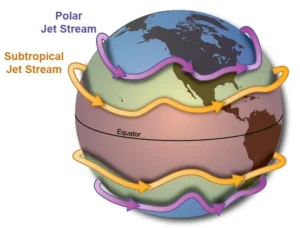
- Jet Streams occur in both the Northern and Southern Hemispheres.
- Since these hot and cold air mass boundaries are most pronounced in winter, Jet Streams are the strongest during both the northern and southern hemisphere winters.
- Jet Streams also “follow the Sun” – they move northward and southward with the apparent movement of the Sun.
- In summers they move poleward and in winters they shift equatorward.
What causes Jet Streams?
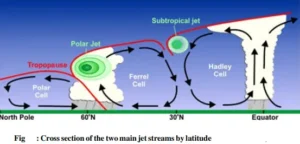
- Jet Streams form when warm air masses meet cold air masses in the atmosphere.
- When Earth’s warmer air masses meet cooler air masses, the warmer air rises up higher in the atmosphere while cooler air sinks down to replace the warm air.
- This movement creates an air current, or wind. A jet stream is a type of air current that forms high in the atmosphere.
What are the four primary Jet Streams?
- Earth has four primary Jet Streams: two polar Jet Streams, and two subtropical Jet Streams.
- The regions around 30° north and south of equator and 50°-60° north and south of equator are areas where temperature changes are the greatest.
- As the difference in temperature increases between the two locations the strength of the wind increases.
- Therefore, the regions around 30° N/S and 50°-60° N/S are also regions where the wind, in the upper atmosphere, is the strongest.
- The 50°-60° N/S region is where the polar jet is located with the subtropical jet is located around 30°N.
- Earth’s four primary Jet Streams only travel from west to east. So, Jet Streams typically move storms and other weather systems from west to east.
Subtropical Jet Streams Vs Polar Jet Streams
- A subtropical jet is predominantly a high-altitude feature.
- In contrast, eddy-driven Polar Jet Streams are deeper, and it is these specifically, which reach all the way down to the surface.
- The two jets are sometimes separated in latitude (often this is the case over the Atlantic Ocean), but sometimes merged together (as is more common over the Pacific Ocean) forming a broader region of mid-latitude west-to-east winds.
Why do the Jet Streams move from west to east?
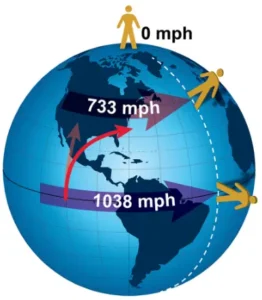
- The rotational speed of the Earth’s surface, and thus the air above it, decreases from equator towards poles.
- As a result, air moving away from the equator does not move directly north and south because it retains this rotational momentum, causing it to rotate faster than the surface below as it moves toward the poles.
- Therefore, as air moves towards the poles, it also moves from west to east relative to the surface. This is the Coriolis effect.
- This Coriolis force deflects the north-south transport of heat from the equator to the poles into the predominantly east-west motion of the jet stream.
Why do Jet Streams not flow in a straight path from west to east?
- The Jet Streams normally do not flow in a straight path from west to east, but rather meander in alternating troughs and ridges. These waves are called Rossby waves.
- There are two major reasons for these non-zonal motions: the temperature gradient between the equator and the poles and the presence of land masses on the earth’s surface.
- The meridional temperature gradient between the equator and poles that gives rise to the jet stream also produces secondary atmospheric circulations, or eddies.
- The eddies modify the distribution of temperature and kinetic energy within the atmosphere, a process that has a pronounced effect on the location and movement of the jet stream.
- And the jet stream itself interacts with these waves, not only as a transport or steering mechanism but also in the transfer of momentum and energy back to the waves.
- The presence of land masses on the earth’s otherwise watery surface modifies the distribution of temperature, because continents heat and cool at a dramatically different rate than do the oceans.
- The topography of the land also influences the jet stream’s location. Mountain ranges and plains on large continents, for example, significantly affect the distribution of atmospheric temperature.
- And since the jet stream is a thermally driven phenomenon, the more complicated the three-dimensional temperature structure of the earth’s atmosphere, the more ‘wandering’ will take place in the course of the jet stream.
How do Jet Streams affect weather?
- Jet Streams play a significant role in determining the weather conditions in lower atmosphere.
- The fast-moving air currents in a jet stream can transport weather systems, affecting temperature and precipitation.
- However, if a weather system is far away from a jet stream, it might stay in one place, causing heat waves or floods.
- Thus, movement of Jet Streams is also important in determining prolonged periods of floods or droughts.
- The path followed by temperate cyclones or mid-latitude weather disturbances are largely controlled by these upper air circulations.
- So, we see that surface meteorological conditions are highly affected by the path of Jet Streams.
- Jet Streams also affect the regularity of monsoonal winds.
Jet Streams and El Nino
- When an El Nino causes excess heating in the tropical Pacific upper atmosphere, the air flow toward the poles becomes more vigorous.
- El Nino tends to lead to an elongated Subtropical Jet Stream that can extend all the way to North America and bring an above-average supply of storms across the southern part of the United States.
How are Jet Streams linked to heatwaves?
- Scientists believe the recent global heatwaves are linked to a strange pattern in the jet stream that has been called “wavenumber 5.”
- When the jet stream forms into a U-bend shape, it can generate heatwaves. Five of these U-bends are currently circling the world in a pattern.
- This pattern is what scientists are calling wavenumber 5, and that it “can persist for weeks, causing hot areas to stay hot for a long time”.
Jet Streams and Indian Weather
a) Subtropical Westerly Jet Stream
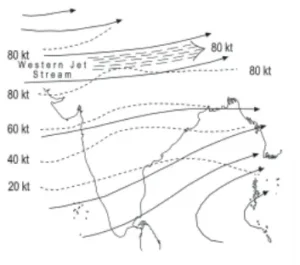
- Over India, the subtropical westerly Jet Stream blows south of the Himalayas (27°-30° north latitude), all through the year except in summer.
- This subtropical westerly jet stream is largely responsible for bringing winter rainfall experienced in the north and north-western parts of the country through Western Cyclonic
- Disturbances.
-
- An increase in the prevailing night temperature generally indicates an advance in the arrival of these cyclones disturbances.
- Meteorologists have found an interrelationship between the northward shift of the equatorial trough, also known as the Inter Tropical Convergence Zone (ITCZ), and the withdrawal of the westerly jet stream from over the North Indian Plain.
b) Easterly Jet Stream
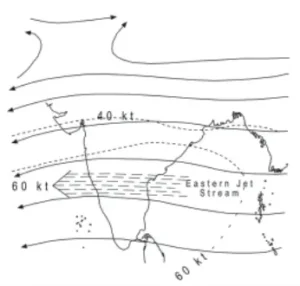
- In summer, the subtropical westerly jet stream moves north of the Himalayas with the apparent movement of the sun.
- An Easterly Jet Stream, called the sub-tropical easterly jet stream blows over peninsular India, approximately over 14-15°N during the summer months.
- This Jet Stream owes its origin to heating of Tibetan plateau due to shifting of Sun’s rays to northern hemisphere.
- This easterly Jet Stream runs from the east coast of Vietnam to the west coast of Africa.
- The easterly jet stream sets in along 15°N latitude only after the western jet stream has withdrawn itself from the region.
- This easterly jet stream is held responsible for the burst of the monsoon in India.
- Around the time of the arrival of south-west Monsoon in India, the normal rainfall increases suddenly and continues constantly for several days. This is known as the ‘burst’ of the monsoon
During Break monsoon conditions Easterly Jet Stream moves northwards up to latitude 20ºN.
- During the south-west monsoon period after having rains for a few days, if rain fails to occur for one or more weeks, it is known as break in the monsoon.
- During the active periods of monsoon, the axis of the Tropical Easterly Jet Stream (TEJ) is located near 5ºN latitude and during break periods it is located around 15ºN latitude.
- Intensity of the Easterly Jet Stream is weak (strong) during El Nino (La Nina) events.
- Besides, a strong Easterly Jet Stream is associated with excess Indian Summer monsoon rainfall and vice-versa.
- The Easterly Jet Stream also steers the tropical depressions into India.
- These depressions play a significant role in the distribution of monsoon rainfall over the Indian subcontinent.
- The tracks of these depressions are the areas of highest rainfall in India.
How do Jet Streams affect air travel?
- Jet Streams are located about 8-14 kms above Earth’s surface in the mid to upper troposphere and generally blow from west to east.
- Airplanes also fly in the mid to upper troposphere. So, if an airplane flies in a powerful jet stream and they are traveling in the same direction, the airplane can get a boost.
- That’s why an airplane flying a route from west to east can generally make the trip faster than an airplane traveling the same route east to west.
Ring of Fire
- News: Taiwan is prone to earthquakes as it lies along the Pacific “Ring of Fire”.
- The Formation of the Ring of Fire:
-
- The Ring of Fire is a distinctive geological feature, spanning approximately 40,250 kilometers along the Pacific Ocean.
- Shaped like a semicircle or horseshoe, it is characterized by a string of hundreds of volcanoes and earthquake-prone sites.
- This phenomenon is attributed to the convergence of multiple tectonic plates, including the Eurasian, North American, Juan de Fuca, Cocos, Caribbean, Nazca, Antarctic, Indian, Australian, and Philippine plates, encircling the vast Pacific Plate.
- It runs through 15 more countries including the USA, Indonesia, Mexico, Japan, Canada, Guatemala, Russia, Chile, Peru, and the Philippines.
-
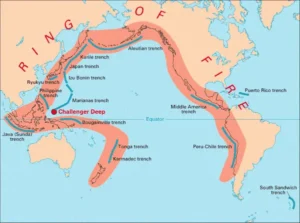
The Proliferation of Volcanoes:
- The proliferation of volcanoes within the Ring of Fire is closely linked to the movement of tectonic plates.
- Many of these volcanoes are formed through a process known as subduction, wherein two plates collide and the denser oceanic plate is forced beneath the lighter continental plate, creating deep trenches.
- This process leads to the generation of magma, which subsequently rises through the overlying plate and erupts at the surface, forming volcanoes.
- The prevalence of subduction zones within the Ring of Fire contributes to its high concentration of volcanoes, making it one of the most geologically active regions on Earth.
- Notably, Taiwan experiences significant earthquakes due to the convergence of the Philippine Sea Plate and the Eurasian Plate.
GS Paper 2
NATO
- News: NATO foreign ministers recently celebrated the 75th anniversary of their alliance.
- NATO:
- Establishment: NATO was formed in 1949 with the aim of acting as a deterrent to the threat of Soviet expansion in Europe after World War II.
- The Washington Treaty – or North Atlantic Treaty – forms the basis of the NATO.
- Purpose: The organization acts as a collective security alliance with the aim of providing mutual defense through military and political means if a member state is threatened by an external country. (Article 5 of the North Atlantic Treaty).
- Founding Founders: Its 12 founding members are the United States, the United Kingdom, Belgium, Canada, Denmark, France, Iceland, Italy, Luxembourg, the Netherlands, Norway and Portugal.
- Total Members: NATO has 32 members, including recent additions of Finland and Sweden.
What is NATO’s ‘Collective Defense Mechanism’?
-
- Article 5: The principle of collective defence is at the very heart of NATO’s founding treaty. It is enshrined in Article 5 of the Washington Treaty.
- Meaning: Collective defence means that an attack against one Ally is considered as an attack against all Allies.
- Instances where it was used?
- NATO invoked Article 5 for the first time in its history after the 9/11 terrorist attacks against the United States.
- NATO has taken collective defence measures on several occasions, including in response to the situation in Syria and the Russian invasion of Ukraine.
- Standing forces: NATO has a number of standing forces on active duty that contribute to the Alliance’s collective defence on a permanent basis.
-
-
- These include NATO’s four standing maritime group fleets, which are ready to act when called upon.
-
-
- Additionally, NATO has an integrated air defence system that links national air defence capabilities together and includes the Alliance’s ballistic missile defence capabilities.
- Troops and Equipment: When the Alliance collectively decides to conduct an operation, it asks Allies for troops and equipment to be placed under NATO command.
Challenges of NATO:
- Eastward Expansion Dynamics: NATO’s expansion towards the east, encompassing Baltic states and countries like Finland and Sweden, has triggered apprehensions from Russia, escalating geopolitical tensions in the region.
- Divergent Perspectives: The alliance grapples with internal discord as member nations possess diverse interests and approaches, posing obstacles to cohesive decision-making processes.
- Financial Strains: Concerns persist regarding adequate funding from member nations for NATO operations, emerging as a contentious issue. This challenge gains further prominence amid discussions, particularly in light of potential shifts in U.S. leadership, where calls for increased contributions to uphold the principle of mutual defense resonate.
NATO’s Approach to Addressing Global Security Challenges:
- Responding to Regional Dynamics: NATO’s recent expansions, notably including Finland and Sweden, reflect concerns over Russian aggression, particularly in the aftermath of the Ukraine invasion, underscoring the alliance’s commitment to collective defense.
- Expanding Geographic Focus: Acknowledging the shifting geopolitical landscape, NATO is broadening its strategic scope beyond Europe, with a heightened emphasis on the Indo-Pacific region, where it grapples with challenges posed by China’s ascendancy.
- Forge Strengthened Partnerships: NATO is cultivating diverse global partnerships with countries like Australia, Japan, and South Korea, recognizing their pivotal roles in bolstering regional security and fostering cooperation beyond traditional alliance
- Commitment to Security Assistance: In a demonstration of solidarity and commitment to addressing security threats, NATO is devising a substantial $100 billion aid package for Ukraine, signaling its proactive stance in supporting nations facing complex security challenges.
- In sum, NATO navigates a multifaceted landscape characterized by regional tensions, global power shifts, and evolving security threats. By adapting its strategies, fostering partnerships, and demonstrating collective resolve, NATO aims to uphold its core principles of security and stability in an increasingly complex world.
Living Will
- News: Recently many doctors, nurses, and volunteers of the Pain and Palliative Care Society signed ‘living wills’ in Thrissur, Kerala.
Living Wills,:
-
- They are also known as advance medical directives.
- They are legal documents that allow individuals to specify their preferences for medical treatment in the event they become incapacitated and are unable to communicate their wishes.
- Living wills gives control to an individual on how he or she should be treated in case of incapacitation.
- It also gives clarity to family members who would otherwise have to make difficult decisions on medical care and life support systems.
Validity of living wills in India:
-
- The Supreme Court, in a landmark judgment in 2018, accepted and recognised the “right to die with dignity” as part of the fundamental ‘Right to Life’ under Article 21 of the constitution.
- The court observed that every adult individual with the mental capacity to make an informed decision has the right to refuse medical treatment, and life support systems, by executing an advance medical directive or a living will.
- The apex court said that these advance medical directives can be applied only in specific cases, where a patient becomes terminally ill and is not able to convey that the treatment must stop.
New Guidelines by Supreme Court:
-
- Simplified Documentation Requirements: The Supreme Court, led by Justice KM Joseph, implemented revisions to the 2018 guidelines for the registration and enforcement of living wills.
- Witness and Attestation Requirements: Under the new guidelines, a living will must be signed and witnessed by two independent individuals.
-
-
- Notably, attestation by a notary or a gazetted officer now suffices, replacing the previous mandate for attestation by a judicial magistrate of first class.
-
-
- Clarification of Decision-Making Authority: The revised guidelines mandate explicit mention of the guardian or close relative authorized to make decisions regarding withdrawal of medical treatment in the event of the maker’s incapacitation.
- Revised Composition and Expertise of Medical Boards: Previously, medical boards were required to consist of three doctors with a minimum of 20 years’ experience in various medical fields.
-
-
- However, under the updated guidelines, the minimum experience requirement has been reduced to five years, with at least two doctors designated as subject experts.
-
-
- Timely Review Processes: Both the primary and secondary medical boards are now expected to provide their opinions within 48 hours of receiving a case referral, facilitating quicker decision-making processes.
- Recourse in Case of Disagreement: In instances where there is a disparity of opinions between the primary and secondary medical boards, or if both boards refuse permission, the patient’s next of kin reserve the right to petition the High Court. The High Court may then establish a new medical board to reassess the case.
Challenges in Implementing Living Wills in India:
-
-
- Custodian Appointment Delay: State governments’ failure to designate custodians for living wills has led to delays and legal interventions, exemplified by recent litigation in the Bombay High Court for statewide custodian appointments.
- Protocol Absence: The National Health Authority’s omission of protocols for authenticating living wills through digital health records complicates their verification process.
- Procedural Complexity: Guidelines stipulate the inclusion of a doctor nominated by the chief medical officer in secondary medical boards, hindering hospitals’ ability to establish such boards promptly.
-
-
- Consequently, terminally ill patients, despite having living wills, face challenges in making crucial medical decisions.
-
-
-
- Ambiguous Guidelines: Ambiguities in Indian law regarding the definition of ‘next of kin’ and the resolution of disagreements among family members regarding medical care decisions contribute to officials’ reluctance to act on sensitive matters.
- State Government Inertia: The intricate nature of the subject, requiring expertise from medical and legal professionals, leads to hesitancy among state governments to implement living wills with vigor and determination.
Way Forward:
-
- There is a need for wider awareness, dialogue and active participation from society and various stakeholders to influence policymakers into framing strong and practical laws for execution and enforcement of living wills.
GS Paper 3
Shaping the Landscape of Shrimp Farming in India
- News: India is the top supplier of shrimp to the U.S.
- Shrimp Farming in India:
- India is the world’s second-largest producer of whiteleg shrimp (Litopenaeus vannamei), yielding close to 1 million metric tons each year.
- India has emerged as one of the world’s largest shrimp exporters.
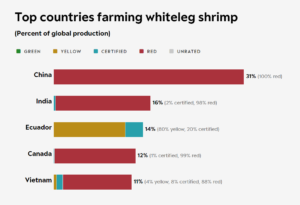
- India’s share in the U.S. market has risen from 21% or $1.3 billion to 40% in 2022-23 with shipments worth $2.4 billion, far ahead of rivals like Thailand, China, Vietnam and Ecuador.
- Andhra Pradesh alone accounts for almost 70% of India’s shrimp output.
Mother of Dragons’ Comet
- News: The Comet 12P/Pons-Brooks, also known as the ‘Mother of Dragons,’ is currently visible in the skies of the Northern Hemisphere. Stargazers have the opportunity to observe this comet as it comes near to Earth.
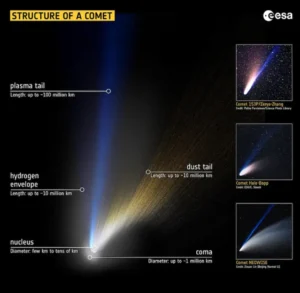
- Characteristics of Comet 12P/Pons-Brooks: It’s a ‘Halley-type’ comet with a 30-kilometer-wide nucleus that orbits the Sun every 71 years.
-
- Classified as a Jupiter-family comet, its path is affected by Jupiter’s gravity.
-
- Visual Observations and Naming: Known as the ‘Mother of Dragons,’ inspired by “Game of Thrones,” and also linked to the “kappa-Draconids” meteor shower.
- Comet Composition and Activity: Made of ice, dust, and rocks; changes visibility as it approaches the Sun.
-
- Ice turns to gas, forming a cloud and tail pushed by solar wind.
-
- Observation Opportunities: Best seen in late March and early April post-dusk; binoculars or a small telescope help.
-
-
- Closest to Earth in June 2024.
-
- Astronomical Significance: Helps scientists understand comets and the solar system’s evolution over time.
- Characteristics of the Comet:
-
- Comet 12P/Pons-Brooks is known as a ‘Halley-type’ comet, boasts a nucleus approximately 30 kilometers in diameter and orbits the Sun every 71 years. Classified as a Jupiter-family comet, its trajectory is influenced by the gravitational pull of Jupiter.
-
Nuclear Power
- News: A study by academics at the Indian Institute of Management, Ahmedabad suggests that for India to become a developed country by 2047 and achieve net zero carbon dioxide emissions by 2070, it needs to focus on investing in nuclear energy and expanding related infrastructure.
- Energy Mix: Solar energy currently contributes 16% to India’s installed generation capacity, while coal holds the majority share at 49%.
-
-
- However, nuclear energy remains relatively low at 1.6%, according to the Central Electricity Authority.
-
-
- Nuclear Energy in India:
- India was among the pioneers in adopting nuclear energy.
- In 1948, just one year after gaining independence, the country enacted its first Atomic Energy Act and embarked on the journey of nuclear energy development.
- Initially, India introduced small reactors manufactured by General Electric, eventually becoming the first Asian nation to operate nuclear power plants in 1969.
- Currently, nuclear energy makes up only 1.6% of India’s energy mix.
- Recently a 700 MW nuclear power plant has been inaugurated by PM of India, entirely developed within India, situated in Kakrapar, Gujarat.
-
-
- Nuclear power plant projects with a capacity of 700 MW each are underway at two other locations: Rawatbhata in Rajasthan (RAPS 7 and 8) and Gorakhpur in Haryana (GHAVP 1 and 2).
-
-
- Recently, Unit 4 of the Kakrapar Atomic Power Project (KAPP 4–700 MW) reached a significant milestone by achieving criticality, marking the commencement of a controlled fission chain reaction, for the first time.
- India has approved plans to establish a 6 x 1208 MW nuclear power plant in collaboration with the USA at Kovvada in Srikakulam district, Andhra Pradesh.
- Importance of Nuclear Energy for India:
- Nuclear power’s role as a clean environment-friendly source of continuous electricity is essential for India’s sustainable energy future and its goal of achieving a net zero economy by 2070.
- India currently operates 23 nuclear power reactors, which have generated approximately 411 billion units of electricity over the past ten years, preventing the release of about 353 million tons of CO2 equivalent.
- The Central Government has initiated steps to triple its nuclear power capacity from the current 7,480 megawatts (MW) to 22,480 MW by 2031-32.
- Annual electricity generation from nuclear power plants has increased from 35,334 million units in 2013-14 to 46,982 million unit in 2022-23.
- Key Findings of the Study:
- In the most optimistic scenario, emissions could drop to 0.55 billion tonnes of carbon dioxide by 2070, achieving a ‘net zero’ status.
- To reach this goal, nuclear power needs to increase significantly: from the current level to 30 gigawatts (GW) by 2030 and 265 GW by 2050.
- Funding these changes would require approximately Rs. 150-200 lakh crore between 2020 and 2070.
